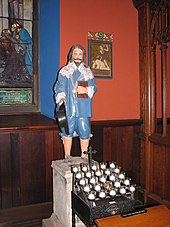King Charles the Martyr
He believed in a sacramental version of the Church of England, called High Anglicanism, with a theology based upon Arminianism, a belief shared by his main political advisor, Archbishop William Laud.
It is known the regicides approached Richard Brandon, the common Hangman of London, but that he refused, and contemporary sources do not generally identify him as the King's headsman.
According to Philip Henry, the decapitation was greeted by a moan from the assembled crowd, some of whom then dipped their handkerchiefs in Charles' blood, thus starting the cult of the Martyr King.
In an unprecedented gesture, one of the prominent leaders of the revolutionaries, Oliver Cromwell, allowed the King's head to be sewn back on his body so the family could pay its respects.
Charles was buried privately and at night on 7 February 1649, in the Henry VIII vault inside St George's Chapel in Windsor Castle.
[1] Mandell Creighton, Bishop of London, wrote "Had Charles been willing to abandon the Church and give up episcopacy, he might have saved his throne and his life.
In addition, a proclamation made at the beginning of each reign from Charles II to Victoria annexed special services for these days to the Prayer Book by royal mandate (approved unanimously by Convocation).
Vernon Staley in 1907 described the deletion as ultra vires and "a distinct violation of the compact between Church and Realm, as set forth in the Act of Uniformity which imposed the Book of Common Prayer in 1662".
[9] Of the three commemorations, only that of King Charles I has been restored in the calendar in the Alternative Service Book of 1980 – although not as a Red Letter Day – and a new collect composed for Common Worship in 2000.
There are Anglican churches and chapels dedicated to Charles King and Martyr in England, Scotland, Ireland, the United States, Australia, and South Africa.


